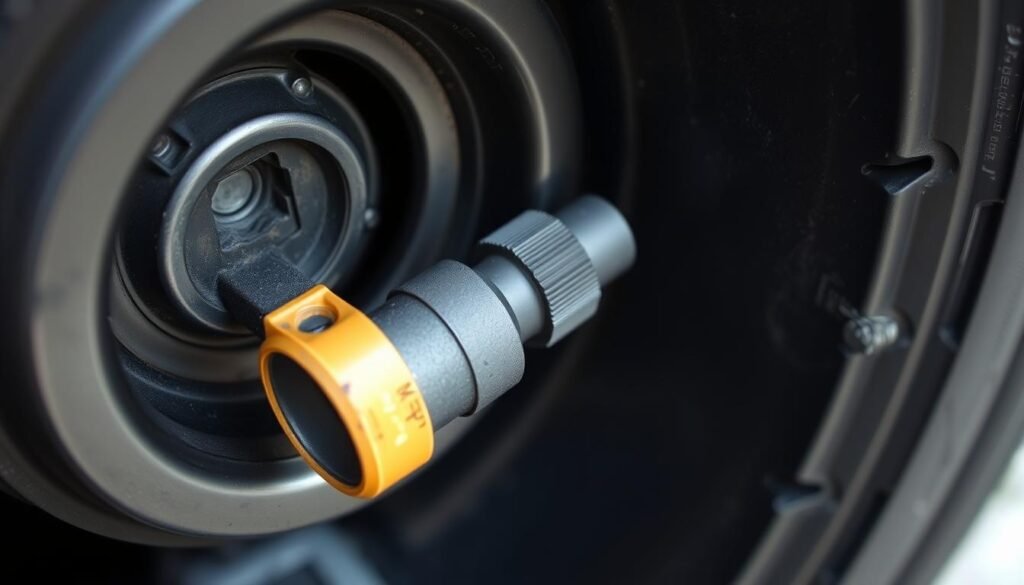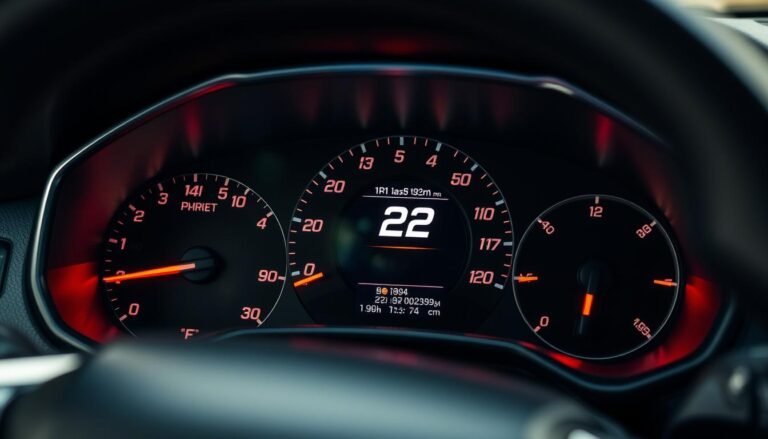Ford Fusion Tire Pressure Sensor Fault? Essential 7 Info
Many drivers face the issue of a Ford Fusion tire pressure sensor fault. Fixing it quickly is key for your safety and car’s performance.
A bad sensor can make your car use more fuel and affect your driving control. It’s vital to know the signs of a tire pressure sensor fault in your Ford Fusion.
Taking the right steps can fix the problem. This guide will help you understand the Tire Pressure Monitoring System (TPMS) in your car.
You’ll learn how to spot common symptoms of sensor faults. We’ll also show you how to troubleshoot the issue.
Keeping your tires in good shape and getting help when needed can keep you safe and improve your car’s performance.
Let’s explore how to handle your Ford Fusion’s TPMS and ensure your safety on the road.
What is The Tire Pressure Monitoring System (TPMS)?
The Tire Pressure Monitoring System (TPMS) is key in modern cars, like the Ford Fusion. It checks the air pressure in each tire to keep it safe.
The right tire pressure makes driving safer, uses less fuel, and makes tires last longer.
A good TPMS keeps you updated on your tires’ health. It warns you of any problems from low pressure.
What is TPMS?
TPMS alerts drivers to low tire pressure. It uses sensors in the tires to watch pressure levels. If pressure drops too low, it lights up the dashboard warning light.
This helps avoid tire blowouts and makes driving safer.
How TPMS Works in Your Ford Fusion
In the Ford Fusion, TPMS uses sensors to send tire pressure data to the car’s computer. It starts checking pressure when you turn on the engine.
If it finds a problem, it turns on the warning light. It’s important to keep the TPMS working well.
Sensors can be affected by temperature and other things. Watching the TPMS indicators helps prevent tire problems.
Signs of A Tire Pressure Sensor Fault on Ford Fusion
It’s important to know the signs of a tire pressure sensor fault in your Ford Fusion. Look out for the solid air pressure warning light and the TPMS warning message.
These signs are key to keeping your vehicle safe and running well.
Solid Air Pressure Warning Light
A solid air pressure warning light means there’s a problem with the Tire Pressure Monitoring System.
If this light comes on, it means one or more tire sensors might not be working right. You should check it out fast to keep your tires safe and in good shape.
TPMS Warning Message
You might also see a TPMS warning message on your dashboard. This message tells you there’s an issue with the system.
It usually shows up with the solid air pressure warning light. It’s a clear sign you need to find out what’s wrong with your sensors.
Implications of Ignoring TPMS Issues
If you ignore the warning signs, your vehicle could face serious problems. You might see uneven tire wear, lower fuel efficiency, and even safety risks while driving.
Fixing these issues quickly keeps your Ford Fusion running smoothly and safely.
Common Problems with Ford Fusion Tire Pressure Sensor
The Ford Fusion’s tire pressure sensor can face many issues, causing problems for drivers. It’s important to know about these common problems.
One big issue is when the sensor malfunctions, giving wrong or odd readings.
Sensor Malfunction and Erratic Readings
Many Ford Fusion owners face sensor malfunction. This can make tire pressure readings seem off or wrong.
For example, the sensor might say the tires are too low even if they’re fine. This can cause confusion and lead to wrong adjustments. It might also hurt your car’s performance.
If you see these odd readings, you need to check the sensors. They might need to be recalibrated or even replaced.
Environmental Factors Affecting Sensor Performance
Many things in the environment can mess with the tire pressure sensor. Extreme temperatures can change tire pressure, making the sensor less accurate. Also, moisture or dirt can damage the sensor, causing wrong readings.
Knowing about these environmental effects is key to keeping your sensors working right. This helps you catch and fix any problems early on.

| Issue | Description | Potential Solution |
|---|---|---|
| Sensor Malfunction | Erratic or incorrect pressure readings | Check if recalibration or replacement is needed |
| Environmental Impact | Extreme temperatures or exposure to moisture | Regularly inspect and maintain sensors |
Causes of Ford Fusion Tire Pressure Sensor Fault
Knowing why your Ford Fusion’s tire pressure sensor might go wrong is key to keeping your car in top shape. One big reason is not taking care of your tires right.
If you don’t check and maintain them, the sensor can fail, which is dangerous.
Improper Tire Maintenance
Keeping your tires in good condition is vital for your Ford Fusion’s tire pressure sensor. If you ignore checking the tire pressure, you might face problems. Here are some issues:
- Under-inflated tires can cause higher friction, leading to inaccurate sensor readings.
- Over-inflation may increase the risk of tire damage, impacting sensor functionality.
- Failure to rotate tires can affect wear patterns, which may result in erratic sensor behavior.
By keeping the tire pressure right and getting regular checks, you can make your TPMS work better.
Temperature Influence on Tire Pressure
Changes in temperature really affect tire pressure. Cold weather makes tire pressure go down, which might light up your dashboard.
When it gets colder, the air in your tires gets tighter, making the sensor send out warnings if the pressure is too low.
On the other hand, hot weather makes tire pressure go up, which also poses challenges.
Knowing how temperature affects your sensor helps you keep an eye on your Ford Fusion’s tire health.

Troubleshooting Ford Fusion Tire Pressure Sensor Fault
Fixing problems with your Ford Fusion’s tire pressure sensor needs a careful plan. Regular checks of tire pressure are key to solving issues.
Keeping an eye on your tire pressure helps spot problems early and fix them.
Checking Tire Pressure Regularly
Check your tire pressure every month or when the weather changes a lot. Use a good tire pressure gauge for accurate readings.
Make sure to compare these readings to what your car’s manual says. This is important because the wrong tire pressure can cause sensor problems.
Resetting The TPMS Light
If the tire pressure warning light stays on after you’ve checked the pressure, try resetting the TPMS light. First, make sure all tires are at the right pressure.
Turn the key to the “on” position but don’t start the car. Find the TPMS reset button under the steering wheel and press it until the light blinks three times.
This can stop false alarms and help fix your tire pressure sensor issue.
Diagnostic Tools For TPMS Issues
Using diagnostic tools can really help you find and fix problems. OBD-II scanners can show error codes for the TPMS.
This lets you fix or replace sensors accurately, keeping your tire pressure system working right.

Benefits of Fixing TPMS Issues Promptly
Fixing TPMS issues quickly has big advantages for car owners. Working tire pressure sensors are key for checking tire pressure and improving driving.
You get safety and efficiency boosts by acting fast on TPMS problems.
Enhancing Safety on The Road
Quickly fixing TPMS issues makes driving safer. Right tire pressure helps your car handle better. It also means safer stops and less chance of accidents.
When sensors work right, you can rely on their info. This makes driving safer for everyone.
Improving Fuel Efficiency
Fixing TPMS issues also saves fuel. Low tire pressure means your car uses more gas. Keeping tires at the right pressure saves money and cuts down on emissions.
By fixing TPMS problems fast, you get financial and environmental benefits. Your car runs better and more efficiently.

Professional Help For Tire Pressure Sensor Issues
Knowing when to get help for tire sensor problems is key for your Ford Fusion’s safety and performance.
It’s important to know when to visit a mechanic for TPMS issues. This can save you time and prevent expensive repairs later.
If warning lights stay on after checking your tires or if tire pressure readings are off, see a mechanic. It’s a smart move.
When To Visit A Mechanic
If the TPMS warning won’t go away, it’s time to get professional help. Ignoring these alerts can cause bigger problems, like safety issues or lower fuel efficiency. Look out for these signs:
- Persistent illumination of the TPMS warning light
- Inaccurate or fluctuating tire pressure readings
- Feeling a difference in handling or ride quality
Learning Diagnostic Reports
When you take your car to a pro, they’ll check it out and give you a report. This report will tell you what’s wrong. It helps you understand the problem.
Here’s what you might see:
| Diagnostic Component | Common Issues | Recommended Actions |
|---|---|---|
| Sensor Functionality | Faulty sensors | Replace with OEM sensors |
| Electrical Connections | Corroded or loose wiring | Repair or replace wiring |
| Tire Conditions | Improper tire pressure | Adjust tire pressure to specifications |
Ford Fusion Tire Pressure Sensor Fault: Customer Experiences
Many Ford Fusion owners have shared their insights on tire pressure sensor faults. They talk about a solid air pressure warning light even when tires are properly inflated.
This has led to various real life TPMS solutions as drivers look for ways to fix these problems.
Real Life Examples and Solutions
Several Ford Fusion owners have found ways to fix TPMS issues. Resetting the system often makes the warning light go away.
In tougher cases, replacing faulty sensors works well. These stories show how important it is to stay on top of TPMS problems.
Community Feedback on TPMS Performance
The Ford Fusion community values sharing experiences with tire pressure sensors. They find that acting fast on TPMS alerts can avoid bigger problems
Owners share their findings and solutions on forums, helping others with similar issues.
This helps everyone understand possible TPMS solutions and builds a sense of community.
Conclusion
Knowing about Ford Fusion tire pressure sensor faults is key for safety and performance. Spotting a malfunctioning TPMS lets you act early.
This protects your vehicle and makes driving better. Regular checks keep your TPMS working right. This lets you keep an eye on tire pressure easily.
Managing TPMS well means acting fast on any problems. Not fixing issues can hurt fuel efficiency and safety.
So, take any TPMS warning seriously and get help when needed. This keeps your car in top shape and your mind at ease while driving.
Fixing tire pressure sensor issues makes driving safer and saves fuel. Always watch your Ford Fusion’s TPMS for a better driving experience.
FAQs
Q: What should I do if my Ford Fusion’s TPMS light is on?
A: First, check the tire pressure in all four tires. Make sure they match the recommended levels. If the light stays on, try resetting the TPMS or see a mechanic.
Q: How can I reset the tire pressure sensor on my Ford Fusion?
A: To reset the sensor, turn the ignition to ON without starting the engine. Press the gas pedal three times, then turn it off. This might fix the TPMS light. If it doesn’t, you might need more help.
Q: What are common issues that cause the tire pressure sensor fault?
A: Issues include sensor problems, bad tire care, and weather changes. Regular checks can help avoid these problems.
Q: How often should I check my tire pressure?
A: Check your tire pressure monthly and before long drives. Also, check it when the weather changes a lot.
Q: Can I drive with a faulty tire pressure sensor?
A: Driving with a faulty sensor is not safe. It can cause tire pressure errors, leading to bad handling and blowouts. Fix it quickly for your safety.
Q: What does it mean if my TPMS displays erratic readings?
A: Erratic readings mean a sensor problem or TPMS system issues. This could be due to a dead sensor battery or weather. You should troubleshoot it.
Q: When should I seek professional help for TPMS issues?
A: Get professional help if the TPMS light won’t go away after checking and resetting. A mechanic can find and fix the problem.
Q: Is a faulty tire pressure sensor covered under the warranty?
A: Warranty coverage for a faulty sensor depends on your vehicle’s warranty. Check your warranty or ask your dealer for details.







